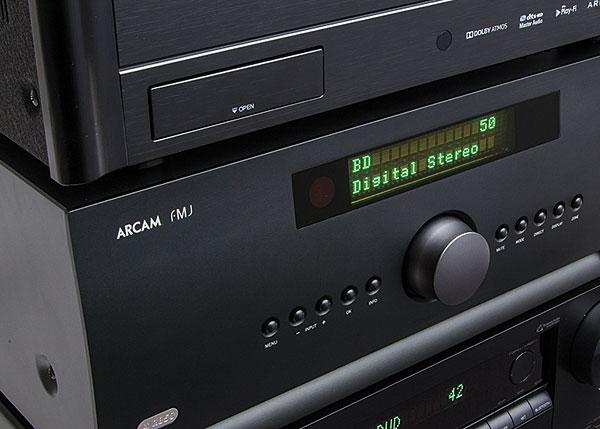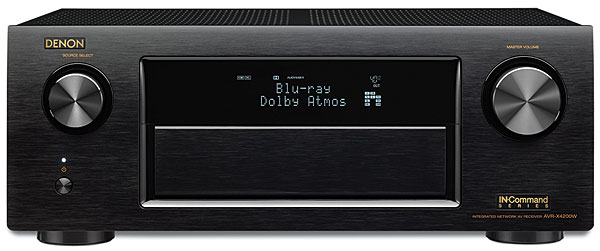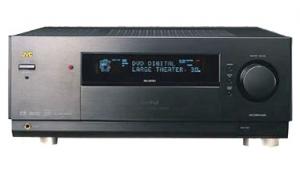How to Buy an A/V Receiver

I exaggerate, of course—though probably not much. Certainly, the ease of installation and operation associated with soundbars and compact wireless speakers deserves credit for turning a whole new audience on to better movie and music sound quality. But if you’re willing to go the oldfashioned route and deal with the more complicated installation of an A/V receiver (AVR), together with speaker boxes and cabling and then perhaps a universal remote that allows everyone in the family to work the system, you’ll be rewarded with performance that all-in-one solutions can’t really approach. That has never been more true than it is today in this era of object-based surround sound. Dolby Atmos and its competitor DTS:X have spawned a new and growing generation of soundtracks that offer overhead special effects and ambience that are unparalleled. And discrete, AVR-based systems—with their greater power capabilities, connection flexibility, and widely spaced speakers—represent the best way to enjoy the new software.
What’s in the Box?
For those unaware, an A/V receiver combines two separate audio components in a single chassis: a preamplifier/surround processor (often called a pre/pro or a surround processor) and a multichannel power amplifier. The pre/pro is where audio and video switching occurs, allowing you to connect multiple sources to the same AVR and select each with the push of a button. Once selected, the source component (such as a cable box, Blu-ray player, or smart TV, or even your smartphone) delivers a low-level (most likely digital) audio signal to the unit’s preamp section, where it can be manipulated for volume or tone (equalization) adjustments and surround decoding before being sent to the AVR’s power amp section.

The surround processor section decodes the multichannel digital audio bitstream signals from discs, broadcasts, or internet video streams—say, a Dolby Digital or DTS soundtrack—and directs the appropriate sound to each speaker. Matrixsurround signals encoded onto stereo analog tracks will also be decoded here. Alternately, the surround processor can take a twochannel stereo track and derive a form of surround sound from that, utilizing all the additional speakers in the system. Atmos- and DTS:X-capable AVRs allow for both stereo and conventional 5.1-channel and 7.1-channel soundtracks to be mapped out to include their height speakers. Once all that’s done, the multichannel power amp section provides gain to pump up the signal level and drive your speakers to sufficient (if not earthmoving) volume.
How Many Channels?
We consider the basic 5.1-channel configuration to be the minimum speaker requirement for an engaging home theater experience. This includes front left-, front center-, and front right-channel speakers; a pair of surround speakers placed ideally along the side walls (and slightly behind and above the prime seats); and a dedicated powered subwoofer (the .1). Blu-ray Discs and streamed movies that carry discrete high-resolution 7.1-channel soundtracks have become more common in recent years, which helps justify adding back-wall surrounds, but any extra speakers beyond 5.1 channels are an enhancement, not a requirement. If your AVR comes with extra channels, they can often be configured to drive a pair of speakers in another room (usually referred to as Zone 2) or to biamp a suitable pair of front speakers.
Until the introduction of Dolby Atmos and DTS:X surround for the home, the only way to make use of a nine- or even 11-channel AVR (besides running extra zones) was with processing that synthetically derived information for additional front-wall-mounted height or width speakers. With no discrete soundtracks available, the value of adding those extra speakers and amps remained dubious. But object-based surround sound—which provides discrete information to two, four, or even more ceiling-mounted speakers (or Atmos-enabled surrogates) changes that equation. See below for more on object-based surround.
How Much Power?
Amplifier power is a critical spec for any AVR, but it’s difficult to shop by the numbers. Any receiver priced over $500 today is likely spec’d at or near 100 watts per channel, each with something close to the common measurement of 0.1 percent total harmonic distortion (at least, with only one channel running at a time). Typically, this is into an 8-ohm speaker load, though we’re starting to see more AVRs spec’d for a nominal 6-ohm load—essentially a ploy to inflate the power output against competitive models. Stating power at a higher distortion figure will also boost the bottom line. (We consider 1 percent to be the maximum distortion you should accept in most applications where fidelity is critical.)
Confusing, right? Assuming all things being equal (the same power rating for similarly measured amps on similar loads with similar amounts of distortion and with the same type of input signal), what’s the difference between one amp and another? The answer, more or less, is what we call headroom. A great amp with power supply capacity to spare will rise to the occasion on loud, complex passages in multiple channels simultaneously without introducing audible distortion. Other AVRs might sound coarse, or they might run out of steam and clamp down on power output to all the channels (or even shut down temporarily) to avoid overheating.

For a telling sign, look at the five- and seven-channels-driven measurements that we include in the Test Bench of our AVR reviews. Although these torture tests are far more demanding than any realworld situation an AVR is likely to encounter, power output that meets or approaches the published two-channel spec with five or seven channels working all out simultaneously usually indicates a more robust power supply and the ability to drive your system to louder levels with less strain. AVRs that do so are increasingly rare, though, so don’t necessarily penalize one for not delivering the same power with all channels driven. And keep in mind that the amp that achieves this isn’t always the biggest or heaviest. Newer circuit topologies—notably, Class D switching amps—can deliver their power to the speakers more efficiently than traditional, hotter-running Class AB or Class A amps. However, Class D amps vary somewhat more in subjective sound quality compared with the traditional topologies. Read the reviews before you decide.
THX-certified AVRs, when mated with THX-certified speakers, will guarantee the ability to achieve cinema-reference volume level at the listening position in a room whose cubic volume is specified by the level of certification. Other measures of performance, compatibility between components, and simplified setup chores are also accounted for in THX certification. Visit THX.com for more information.
Surround Modes
Acquiring the latest object-based surround processing is perhaps the most compelling reason today for upgrading from an old AVR or purchasing your first receiver instead of an all-in-one soundbar. More on that in a moment, but first, here are some basics.
Every modern receiver offers the same standard surround modes to directly decode the soundtracks embedded in today’s software and broadcasts. Although these are often accompanied by additional playback modes, and experimentation is encouraged, it’s generally best to play back content using whatever mode is native to the original soundtrack. (A reasonable exception might be using the Dolby and DTS “upmixing” modes in Atmos and DTS:X systems to utilize your height speakers.) More often than not, you’ll be listening to core Dolby Digital and DTS surround tracks embedded on DVDs and web video streams, or the high-resolution lossless formats Dolby TrueHD and DTS-HD Master Audio found now on most Blu-ray Discs, including Ultra HD Blu-rays. The latter formats are noticeably superior to the earlier lossy compression formats. Most TV broadcasts carry lossy Dolby Digital; some streaming content from major services like Vudu and Netflix are encoded with Dolby Digital Plus, which provides modest benefits in transmission efficiency or sound quality. Set your new AVR’s surround mode to its automatic setting, and if you’ve selected bitstream audio output from the menus in your Blu-ray player and other digital sources, the receiver should recognize what’s in the source material and set the surround mode accordingly. If you set your player to PCM digital audio output and hook it up via an HDMI connection, full multichannel decoding will usually take place in the player, and it will be indicated as multichannel PCM on the AVR’s display. The sound quality should be about the same either way, though Blu-ray players can only pass the remote control’s button sound effects and the disc’s secondary simultaneous audio tracks if the player is set to PCM. On the other hand, Dolby Atmos or DTS:X encoding, which rides along on the Dolby TrueHD or DTS-HD Master Audio soundtrack, requires that the player be set to bitstream output so the receiver will recognize it.
The next suite of essential listening modes found in AVRs is for decoding matrix-surround-encoded two-channel sources (found on some legacy programming) and converting two-channel stereo recordings or TV shows into quasi surround sound. The best known of these are probably Dolby Pro Logic IIx and DTS Neo:6. These vary in their effectiveness depending on the program material, but one or both are generally available as part of the Dolby and DTS processing package included with the receiver. As mentioned, Atmos- and DTS:X-capable AVRs will feature upmixing capabilities to utilize the height speakers, specifically Dolby Surround (the moniker given to Dolby’s latest audio-upmixing mode) and its DTS counterpart, DTS Neural:X. These can often be effective in picking up spatial cues in stereo and conventional 5.1 and 7.1 soundtracks to create a larger ambient bubble or place effects overhead, though they sometimes can sound unnatural with music.
Then There Was Atmos
More now on object-based surround sound, probably the most important advance in home theater audio since the introduction of the high-resolution lossless surround formats that accompanied the launch of Blu-ray Discs. Long-time home theater enthusiasts may remember some older surround formats—including Dolby Pro Logic IIz, Audyssey DSX, and DTS Neo:X— that appeared in earlier receivers to derive faux signals for front-wall-mounted height and width speakers. These have now become outmoded with the introduction of the object-based surround formats Dolby Atmos and DTS:X. (Some AVRs today also offer Auro-3D processing, which similarly uses height speakers for an enhanced surround effect. This European-based technology requires a different and more elaborate speaker setup than Atmos or DTS:X—and so far, it has failed to catch on in the U.S. It’s not heavily supported by AVR manufacturers, nor is movie software readily available for it at this time. While we consider Dolby Atmos and DTS:X to be an important consideration for future-proofing your AVR purchase, Auro-3D can, for now anyway, be largely dismissed by most U.S.-based AVR shoppers.)



















































